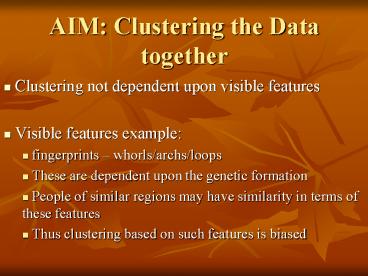AIM: Clustering the Data together - PowerPoint PPT Presentation
Title:
AIM: Clustering the Data together
Description:
Statistical data mining Tutorial s. Andrew Moore (http://www-2.cs.cmu.edu/~awm/tutorials/kmeans.html) A Tutorial on clustering algorithms ... – PowerPoint PPT presentation
Number of Views:28
Avg rating:3.0/5.0
Title: AIM: Clustering the Data together
1
AIM Clustering the Data together
- Clustering not dependent upon visible features
- Visible features example
- fingerprints whorls/archs/loops
- These are dependent upon the genetic formation
- People of similar regions may have similarity in
terms of these features - Thus clustering based on such features is biased
2
Letting the Data speak
- Collect the data samples from the test domain
- Cluster the data based on some clustering
algorithm
3
Clustering Algorithm used
- K-means clustering Algorithm
- Algorithm in short
- Start with a predefined number of clusters
- Initialize the clusters with a certain centroid
- Run the algorithm to associate each member point
- to a cluster
- Re-calculate the centroids
4
K-means clustering algorithm
- Place K points into the space represented by the
objects that are being clustered. These points
represent initial group centroids. - Assign each object to the group that has the
closest centroid. - When all objects have been assigned, recalculate
the positions of the K centroids. - Repeat Steps 2 and 3 until the centroids no
longer move. This produces a separation of the
objects into groups from which the metric to be
minimized can be calculated.
5
Algorithm Evaluation
- Non-intuitive, yet true
- Always Converges
- Reason finite number of ways of partitioning R
into k groups - Each time the configuration changes, we go to an
improved distortion (sum of square error) - Every iteration new configuration
- If run forever, number of configurations exhaust
6
Algorithm Evaluation
- Convergence does not guarantee Optimality
- To Assure a near-Optimal solution
- Careful selection of starting points
- Several runs of the Algorithm
7
Selecting the starting points
- Using the k-nearest neighbor concept
- k corresponds to the number of clusters
- Find the global mean of the entire dataset
- Find the 'k' - closest data points to the global
mean - These 'k'-closest data samples are the initial
'k'- centroids.
8
The code so far.
9
References
- Statistical data mining Tutorial slides
- Andrew Moore
- (http//www-2.cs.cmu.edu/awm/tutorials/kmeans.htm
l) - A Tutorial on clustering algorithms
- (http//www.elet.polimi.it/upload/matteucc/Cluste
ring/tutorial_html/kmeans.html)































